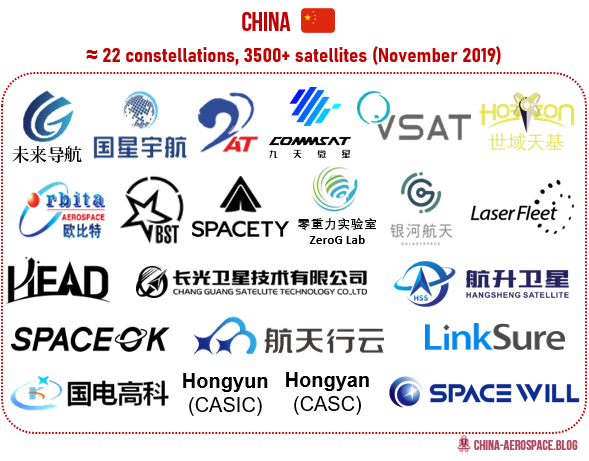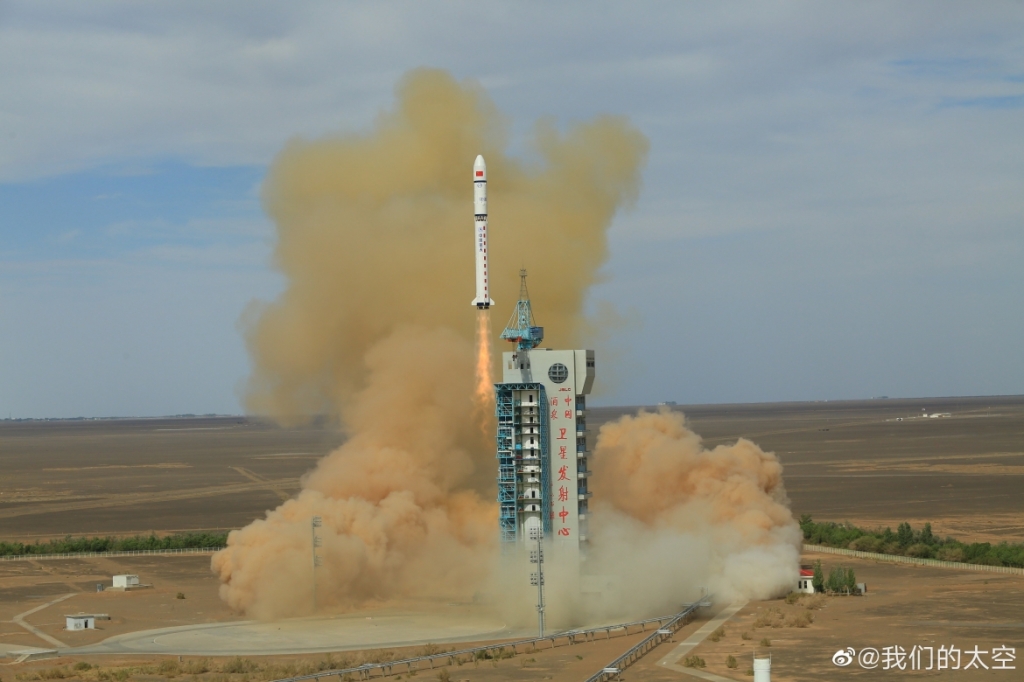In one of the most influential entrepreneurship books of the last 10 years, The Lean Startup by Eric Ries describes the necessity to test, iterate, and pivot until ultimately reaching a product that fits the market. Chinese tech companies have shown us that they excel at this practice (see the history of a company like Meituan [1]), and it increasingly seems like Chinese NewSpace companies, notably constellations, have adopted this type of flexibility.

A year ago, I wrote an article on (the many) Chinese constellation projects out there, discussing the potential market they represented for launch startups. Regardless of their level of advancement and financial backing, I came up with over 20 projects, ranging from state-led ventures, state-affiliated “semi-private” spin-offs, and wholy private startups. At the time, this added up to an impressive 3500+ satellites, and raised the central question of: is there actually a market demand for such a high number of constellations from China?

It seems like Chinese constellation startups themselves may slowly be answering this question for us. While many are still on track with their constellation, a significant number have stopped giving updates on the project or seem to have pivoted away from their initial project to focus on another (perhaps less capital intensive) vertical of the space industry. Out of the startups tracked last year, there are many such examples:
- Laserfleet: registered in 2017 in Shenzhen but with teams in Beijing and Shanghai, Laserfleet is a spin-off of SIOM (Shanghai Institute of Optics and Fine Mechanics). It has deep roots in the aerospace industry, with its CEO and main shareholder PAN Yunbin previously leading HNA-affiliated in-flight entertainment and connectivity company Shareco (喜乐航) [2]. Laserfleet initially announced an 288-strong satellite LEO constellation, bringing broadband connectivity to airline flight cabins. The technology was based on an ambitious laser technology rather than the traditional Ku/Ka bands. The satellites would have been built by Chinese cubesat specialist Spacety, which holds a minority stake in the company. Ultimately, Laserfleet’s constellation was taken off its website, and the company has stopped communicating on the project in 2020. Recent activities show that the focus in the future may be put on providing laser-based intersatellite links (ISL) modules for satellites [3].
- LinkSure: LinkSure is an internet company founded in 2013 in Shanghai, and whose core product is a WiFi sharing system on the ground (WiFi 万能钥匙). The company announced in November 2018 its LinkSure Swarm Constellation, a broadband constellation of 272 satellites to provide global coverage by 2026. Perhaps most unconventional of all, LinkSure’s future broadband services would be provided to end-users free of charge [4]. In 2019, it announced it would launch a first satellite, followed by 10 satellites in 2020 [5]. At the time of writing however, there has been no further news of LinkSure’s constellation, nor of the launches planned in 2019 and 2020. While there are rumors of a cancelled launch in 2020, it is possible that the unusual constellation was cancelled altogether.
- Commsat: Commsat is reportedly one of the most promising private companies thus far. Founded in 2015 in Beijing, it has many activities ranging from space education, ground terminal design, to satellite manufacturing and delivery. In the early stages of the company, Commsat had rolled out a roadmap which involved notably developing a 72-satellite IoT constellation. It also launched multiple test satellites in 2018. At the time of writing however, in 2020, it is clear that Commsat has pivoted away from the initial constellation plan and is focusing on growing its satellite manufacturing business [6].
HorizonX, Hangsheng, or VSATTech, as well as many others, have also been oddly silent about their constellation projects*, while often being quite vocal about their other activities, notably upstream satellite manufacturing (in the case of Hangsheng and VSATTech). Could these companies have pivoted away from the constellation business as well? It would seem possible given the competitive environment (see below).
Noteworthily, this doesn’t mean that other Chinese companies aren’t making strides in the development of their constellation, such as Guodian Gaoke (Tianqi), Charming Globe (Jilin-1), or Head Aerospace (Skywalker). All three companies have had multiple launches to deploy their respective constellation in the past year.
*based on my monitoring of the Chinese press and media. If I missed something, feel free to DM me and I will update the post.

Understanding the Pivot
Why have many Chinese startups turned away from satellite constellations? This is notably the case for satcom constellations, which have experienced the highest renouncement rate (note: all the satellite constellations mentioned previously were satcom). On the other hand, Earth observation constellations seem to make more steady progress. There are several reasons to this:
- Cost: satcom constellations, and notably satellite broadband constellations, are extremely capital-intensive. The recent troubles of OneWeb show that even a constellation that has raised over 3 billion USD can face financial difficulties. Amazon has pledged 10 billion USD for its Kuiper constellation, and Elon Musk in March 2020 half-joked at how Starlink was mainly focused on not going bankrupt [7]. This begs the question of whether Chinese private & provincial investors are able to fund such a costly venture. Chinese fund-raising has increased steadily since 2015, but is still no where near US levels.
- Competition with State-owned entreprises: Chinese state-owned space companies, CASC and CASIC, have launched broadband and narrowband constellation projects, which go by the name of Hongyan, Hongyun and Xingyun. CASC and CASIC are extremely well-funded companies, with hundreds of thousands of employees and a turnover in dozens of billions of USD. They also have the country’s most experienced engineers, researchers, and advanced laboratories. And a leaked note in September 2020 showed that the Chinese central government could be planning to file shortly a 12 000+ constellation project with the ITU. As a result, building any private broadband constellation means potentially being in direct competition with these state mastodons.
- Continuous service: satellite broadband constellations need to provide a continuous communications service, and thus need to reach a certain level of completion before commercialization. This is less the case for Earth observation or IoT constellations, which provide services for clients who have much more punctual/periodic needs.
- Regulatory difficulties: providing broadband services is a highly restricted industry in China, and is traditionally the business of the 3 state-owned telecom operators: China Telecom, China Mobile, and China Unicom. It is likely that local broadband constellations will face regulatory barriers comparatively to the state-sponsored projects. This is a notable difference between broadband and narrowband IoT constellations, the latter being a “new” service and not yet covered by a state-owned company. Earth observation constellations also face fewer restrictions, the specific vertical having been relatively commercial for many years.
The upcoming 12-15 months will be key in getting a better picture of which Chinese constellations are here to stay, and which will pivot “to move upstream” to satellite parts/systems manufacturing (see our interview with Lan Tianyi in September 2020 [8]). Two very interesting companies to watch will be Galaxy Space and Geely, which have put forward different value propositions in satellite broadband, and are very well funded. Undeniably a lot of exciting space stuff to come in the final months of 2020, and in 2021.
References
[1] AI Superpowers, Kai-Fu Lee, September 2018
[2] 卫星世界里的新老交替, Pan Yunbin, March 2018
[3] 行云双星发射,中国首次尝试搭建LEO星间激光链路,LaserFleet负责研制主载荷, GNSS World, May 2020
[4] LinkSure Announces 272-Satellite WiFi Swarm Constellation System, SpaceWatch Global, December 2018
[5] 连尚网络启动卫星上网计划, 航天爱好者网, June 2019
[6] China’s Commsat pivots from satellite IoT to broadband with new government policy, Space Intel Report, June 2020
[7] Elon Musk says SpaceX is thinking ‘zero’ about spinning off its Starlink business right now, The Verge, March 2020
[8] Discussing Chinese Satcom Constellations with Lan Tianyi, Dongfang Hour, September 2020
Credits for the article’s top banner image: Commsat


> the company has stopped communicating on the project in 2020
It looks like LaserFleet has run a test:
http://www.parabolicarc.com/2020/08/20/chinese-internet-of-things-constellation-achieves-breakthrough-in-inter-satellite-laser-communications/
Do you have any details on it? Anything further on the project
LikeLike
Hi Larry, thanks for your comment.
When I mentioned that LaserFleet had stopped communicating on the project, I was specifically referring to the laser-based IFC constellation they had initially planned. You can still find hints of this project in old articles dating back to 2017-2019 (see https://www.getconnected.aero/2018/10/china-satellite-laser-based-ifc/).
However recently they have been communicating on their laser-based ISL modules that they are providing to CASIC’s Xingyun constellation, as well as their laser satellite-to-ground systems. Below are two articles they released in Nov 2019 and Aug 2020 (in Mandarin): https://bit.ly/2FpJtnJ and https://bit.ly/34T3bBc
LikeLike